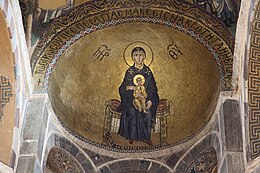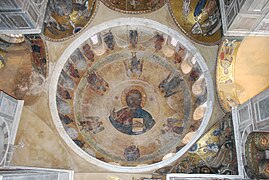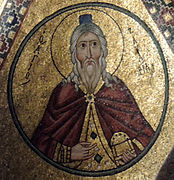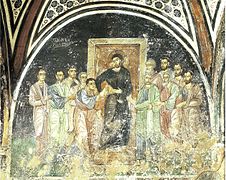Hosios Loukas
| UNESCO World Heritage Site | |
|---|---|
 | |
| Location | Distomo-Arachova-Antikyra Municipality,Boeotia,Central Greece,Greece |
| Part of | Monasteries ofDaphni,Hosios Loukas andNea Moni of Chios |
| Criteria | Cultural: (i)(iv) |
| Reference | 537-001 |
| Inscription | 1990 (14thSession) |
| Area | 1.43 ha (3.5 acres) |
| Buffer zone | 5,443.31 ha (13,450.7 acres) |
| Coordinates | 38°23′43.3″N22°44′48.6″E/ 38.395361°N 22.746833°E |
Hosios Loukas(Greek:Ὅσιος Λουκᾶς) is a historic walledmonasterysituated near the town ofDistomo,inBoeotia,Greece.Founded in the mid-10th century, the monastery is one of the most important monuments of MiddleByzantine architectureandart,and has been listed onUNESCO'sWorld Heritage Sitessince 1990, along with the monasteries ofNea MoniandDaphnion.[1]
History
[edit]The monastery of Hosios Loukas is situated at a scenic site on the slopes ofMount Helicon.It was founded in the early 10th century AD by thehermit,Venerable(Greek:Hosios)Luke of Steiris(Greek:Lukas), whoserelicsare kept in the monastery to this day. St Luke (not to be confused with the Evangelist author of theGospel of Saint Luke), was a hermit who died on 7 February 953. He is famous for having predicted the conquest ofCreteby Emperor Romanos. It was unclear if he was referring toRomanos I,the emperor at the time. However the island was actually reconquered byNicephorus PhocasunderRomanos II.It is believed that it was during the latter's reign (959-963) that the monastery's Church of theTheotokos(Panagia) was constructed.
The main shrine of the monastery is the tomb of St. Luke, originally situated in the vault, but later placed at the juncture of the two churches. The monastery derived its wealth (including funds required for construction) from the fact that the relics of St. Luke were said to have exudedmyron,a sort of perfumed oil which produced healing miracles. Pilgrims hoping for miraculous help were encouraged to sleep by the side of the tomb in order to be healed byincubation.Themosaicsaround the tomb represent not only St. Luke himself, but alsohegumenPhilotheos offering a likeness of the newly built church to the saint.
The saintNicholas the Pilgrim,a local shepherd, lived for some time in the second half of the eleventh century in the monastery until he was expelled due to his abnormal behaviour.[2]Under theLatin Empirein 1206, the legateBenedict of Portogave Hosios Loukas to thecanons of the Holy Sepulchre.[3]
Architecture
[edit]The church
[edit]

The Hosios Loukas, the oldest in the complex, is the only church known with certainty to have been built in the tenth century in its site in mainland Greece.[4]This centralized parallelogram-shaped building is the oldest example of the cross-in-square type in the country; its plan closely follows that ofLips MonasteryinConstantinople.The walls areopus mixtum(part brick, part stone, part marble) and display curiouspseudo-kuficpatterns.
The Hosios Loukas adjoins a larger cathedral church, orKatholikon,tentatively dated to 1011-12. The Katholikon is the earliest extant domed-octagon church, with eight piers arranged around the perimeter of thenaos(nave). The hemisphericaldome(without a drum) rests upon foursquincheswhich make a transition from the octagonal base under the dome to the square defined by the walls below.[5]The main cube of the church is surrounded by galleries and chapels on all four sides.
Decoration
[edit]Hosios Loukas is the largest of three monasteries surviving from the Middle Byzantine period in Greece. It differs from theDaphnionand Nea Moni in that it is dedicated to a singlemilitary saint.St. Lukes' prophecy about the reconquest of Crete is commemorated by the image ofJoshuaon the exterior wall of the Panagia church: Joshua was considered a model "warrior of the faith", whose help was especially effective in the wars waged against the Arabs. The Katholikon contains the best preserved complex ofmosaicsfrom the period of theMacedonian Renaissance.However, the complex is not complete: the original image ofChrist Pantocratorinside the dome is missing, as are the figures of archangels normally placed between the upper windows.
There is evidence that the monastery was reputed all over Byzantium for its lavish decoration, liberally applied to all surfaces. Apart from revetment, carving, gold and silver plate,murals,and mosaics (especially imposing on curving surfaces), the interior featured a choice assortment oficons,chandeliers,silk curtains, andaltar cloths.Only a fraction of these items are stillin situ,most notably colored marble facings and window grilles. Notwithstanding the losses, the Katholikon "gives the best impression available anywhere today of the character of a church interior in the first centuries after the end ofIconoclasm".[6]
The Burial Crypt
[edit]Beneath the great domedKatholikonis a burialcrypt,accessible only by a stairwell on the southern side.

The crypt has three distinct areas: the entrance way; the main interior space which includes ninegroin-vaultedbays and a sanctuary with a vaulted bay and anapse;and three vaulted passages, referred to formerly as bone vaults.[7]
The crypt’sfrescoeswere until recently covered in hundreds of years of dust and hidden but in the 1960s the crypt underwent a cleaning by the Greek Archaeological Service which revealed their remarkably well preserved state with the exceptions of theapsewhich has lost most of its plaster exposing brick and stone, as well as the entrance vault and groin vaults which have suffered slight damage from water seepage and minor vandalism, mostly on the lowerlunettesnear the entrance.[7]
The crypt containsfrescoeson the entryway and its vault, eightlunettesaround the walls with depictions ofChrist’s PassionandResurrection,and forty medallion portraits ofapostles,martyrsand holy men,abbotsincludingPhilotheos,as well as numerous inscriptions. C.L. Connor claims it has "the most complete programme of wall paintings surviving from the MiddleByzantineperiod. "[8]
It is believed that most if not all of thecryptfrescoeswere painted after 1048 AD and the death of Theodore Leobachus, a wealthy, government elite believed to have been one of the prominentpatronsand who later in life became theabbotof Hosios Loukas.[9]
Thesanctuaryof thecryptcontains a prosthesis niche, analtar,and a chancel barrier which all indicate that theEucharistwas likely celebrated here as part of the services of burial and commemoration of revered religious figures, or as part of the ceremonies relating to the healing cult ofSaint Luke.[7]
When Hosios Loukas was frequented bypilgrimsor members ofSaint Luke’s healingcult,visitors would sleep not only in theKatholikon,but in thecryptitself where thetombwas kept along with two others, believed to beabbots.[8]Saint Lukewas believed to have been a miraculous healer,levitator,miraculous feeder and prophesier during his lifetime; after his death, all of themiraclesassociated with him involved the healing power of his tomb. Connor says that accounts inThe Vita of St. Luke,written by an anonymousmonk,indicate that “healing agents” associated with thetombinclude but are not limited to exposure to “oil from the lamp above the tomb, moisture exuded from the tomb, and dreams experienced when sleeping near the tomb in the practice calledincubation.”[7]Thetombwas frequented before and after the completion of the complex, but following completion it became the focal point of the miracle cult ofSaint Luke.There is evidence that some wishing formiraclesstayed for periods of up to six days near thetombor in adjacent rooms.
Gallery
[edit]- Hosios Loukas
-
Interior mosaic with procession of angels
-
Fresco of the interior depicting martyrs
-
View of the dome
-
Clockwise:
St John, Archangel Gabriel, Virgin Mary, Archangel Michael
(narthex mosaic) -
St John
-
St Mark
-
St Michael
-
St Paul
-
Zacharias
-
View of the lower church (crypt)
-
Clockwise:
St Bartholomew, St John the Theologian, St Peter, St Paul (crypt fresco) -
Touching of Thomas/Antipascha
(crypt fresco) -
St Andrew
-
St Luke
See also
[edit]References
[edit]- ^"Monasteries of Daphni, Hosios Loukas and Nea Moni of Chios".UNESCO World Heritage Convention.United Nations Educational Scientific and Cultural Organization.Retrieved20 November2022.
- ^Slootjes, Daniëlle; Verhoeven, Mariette (25 March 2019).Byzantium in Dialogue with the Mediterranean History and Heritage.Brill. pp. 124–126.ISBN9789004393585.Retrieved4 July2023.
- ^Van Tricht, Filip (2011).The Latin Renovatio of Byzantium: The Empire of Constantinople (1204–1228).Brill. p. 450.
- ^Rosemary Morris.Monks and Laymen in Byzantium, 843-1118.Cambridge University Press,1995.ISBN0-521-31950-1.Page 27.
- ^Linda Safran.Heaven on Earth: Art and the Church in Byzantium.ISBN0-271-01670-1.Page 127.
- ^Banister Fletcher's A History of Architecture(ed. by Dan Cruickshank). Architectural Press, 1996.ISBN0-7506-2267-9.Page 310.
- ^abcdConnor, C.L. (1991).Art and miracles in medieval Byzantium: The crypt at Hosios Loukas and its frescoes.Princeton, NJ: Princeton University Press. pp. 3–9, 93–97.
- ^abConnor, C.L."Hosios Loukas".Grove Art Online. Oxford Art Online.Oxford University Press.RetrievedMarch 2,2016.
- ^Oikonomides, Nicolas (1992-01-01). "The First Century of the Monastery of Hosios Loukas".Dumbarton Oaks Papers.46:245–255.doi:10.2307/1291657.JSTOR1291657.
- ^File:Hosios Loukas (narthex) - East wall, right (Harrowing of Hell) 01 (October, 2014) by shakko.jpg
Sources
[edit]- Efthalia Rentetzi,Il Monastero di Hosios Lukas in Focide,in Ειρμός, n. 1, 2004, Αποστολική Διακονία, pp. 227–382, ISSN 1109-9135 (Weblink).
- Efthalia Rentetzi,Elements of Classical Style in the mosaic decoration of Hosios Lukas Monastery Phocis, Greecein ANISTORITON: Art History, Volume 9, June 2005, Section O052 (Weblink).
- Efthalia Rentetzi,Mosaici del monastero di Hosios Lukas in Focide e della basilica marciana: parentele stilistiche,in Arte - Documento, n. 16, 2002, pp. 66–71, ISSNT IT 1121-0524.
- Demus, Otto,Byzantine Mosaic Decoration: Aspects of Monumental Art in Byzantium,Boston, MA: Boston Book and Art Shop, 1955.
- Ousterhout, Robert, "Churches and Monasteries," inThe Oxford Handbook of Byzantine Studies,edited by Robin Cormack, Elizabeth Jeffreys and John Haldon. New York: Oxford University Press, 2008.
- Cormack, Robin, "Wall Paintings and Mosaics," inThe Oxford Handbook of Byzantine Studies,edited by Robin Cormack, Elizabeth Jeffreys and John Haldon. New York: Oxford University Press, 2008.
- Oikonomides, Nicholas. "The First Century of the Monastery of Hosios Loukas," inDumbarton Oaks Papers,vol. 46 (1992).
External links
[edit]- Official Web Site of Hosios Loukas MonasteryArchived2020-11-26 at theWayback Machine(in Greek)
- Hosios Loukas
- Photographs of mosaics
- High-resolution 360° Panoramas ofHosios Loukas | Art Atlas
- Christian monasteries established in the 10th century
- 11th-century Eastern Orthodox church buildings
- Byzantine church buildings in Central Greece
- Monasteries in Central Greece
- Eastern Orthodox church buildings
- World Heritage Sites in Greece
- Buildings and structures in Boeotia
- Tourist attractions in Central Greece
- Macedonian Renaissance architecture
- 11th-century churches in Greece
- Byzantine monasteries in Greece
- Church buildings with domes
- 11th-century establishments in the Byzantine Empire






















